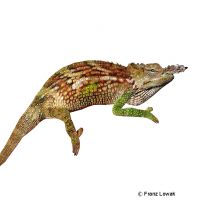Boehme's Two-horned Chameleon (Kinyongia boehmei)
| Boehme's Two-horned Chameleon Kinyongia boehmei | |
|---|---|
| Name | Boehme's Two-horned Chameleon |
| Name Lat. | Kinyongia boehmei |
| Synonym | Bradypodion boehmei |
| Family | Chameleons |
| Family lat. | Chamaeleonidae |
| Order | Scaled Reptiles |
| Order lat. | Squamata |
| Origin | Kenya |
| Habitat | Cloud forests |
| Diet | Insects |
| Humidity | 50-80 % |
| Behavior | Semi-aggressive |
| Keeping | Individual, pair |
| Care Level | Experts only |
| Reproduction | Oviparous |
| Housing | Humid terrarium |
| Life Span | 4-6 years |
| Protection | CITES Appendix II; EU Annex B |
| Metric Units | |
| Size | 22 cm |
| Temperature | 20-26 °C |
| Temperature Local | 28-30 °C |
| Housing Size | 100 x 60 x 100 cm |
| US Units | |
| Size | 8.7" |
| Temperature | 68-79 °F |
| Temperature Local | 82-86 °F |
| Housing Size | 40" x 25" x 40" |
Distribution and habitat
The distribution area of the diurnal Bohemian two-horned chameleons is in the Taita Hills in southeastern Kenya. There they live in the cloud forests and in the scrubland from 1,200 to over 2,000 m altitude, where extreme fluctuations of temperature and humidity prevail.
Maintenance
Minimum dimensions for the terrarium, according to the size and number of animals:
| One animal | 4KRL x 2,5KRL x 4KRL (L x W x H) |
Head-torso length (KRL) is measured on the largest animal. For pair keeping, increase the floor space by 20%. A terrarium of e.g. L 100 x W 60 x H 100 cm is recommended, which should be placed in a quiet and vibration-free place.
They need a well ventilated terrarium structured with branched climbing branches as well as robust (also artificial) plants as a screen, structured back and side walls (e.g. cork covering), a substrate of sand-peat mixture (15 cm deep) and dripping water. A larger part of the substrate should always be kept slightly moist. Once a day, preferably in the evening, the inside of the terrarium should be finely sprayed with water (humidity), but a rain or mist system is better.
| Temp. day: 20-26 °C | Temp. night: 12-18 °C | Temp. local: up to 30 °C | Humidity: 50-80 |
The lighting duration must be 10-14 hrs. depending on the season. They need a high light intensity. Special lamps with high UV-A and UV-B content are ideal.
Diet
The food supply consists preferably of live flying insects, such as moths, houseflies and vinegar flies, bean beetles and aphids are also accepted. Crickets, grasshoppers and crickets are not readily eaten. Wax moths should only be fed in small amounts to adults, but not to juveniles, because of their large fat content. Regular addition of minerals and vitamins (dusting of food) is important. Since water is almost only absorbed in drop form from leaves or furnishings, a dropper is recommended, alternatively they can be watered daily from a pipette
A regular and varied diet promotes health and prevents deficiency symptoms.
Reproduction and breeding
The male has a thicker tail root with a clearly visible hemipenis pouch.
The female buries her eggs (up to 12 pieces) in the substrate. After 8-9 months of incubation and an average temperature of about 20 °C the young hatch. Small flying insects such as fruit flies are suitable as initial food
The life expectancy can be 4-6 years.
Species protection
The animal population must be reported to the competent authority in writing immediately after the start of keeping. Your pet store will be happy to provide you with further information.
Protection of species: WA Appendix II; EU Appendix B. The proof of purchase is the required proof of origin for the animal. Please keep it safe!
Important
Important for their well-being are strong fluctuations of temperature (day-night) and humidity, which should be about 80% in the morning and drop to 50% during the day. Sunny places up to 30 °C are occasionally visited
They are very susceptible to stress
With fruit and honey water as food for the feeders, their quality can be upgraded.
The terrarium must have good ventilation without drafts and meet the species-specific needs. Measuring devices such as thermometers, hygrometers, etc. are necessary. The lighting has to correspond to the species-specific day-night rhythm and has to be placed in such a way that the animals cannot injure themselves. The terrarium should be locked in such a way that neither unauthorized persons can open it nor the animals can escape. Contamination must be removed regularly
Further literature can be found in your pet store.
References
Text: Christian Sänger; Image: Franz Lowak
Source: BMELV (1997): Mindestanforderungen an die Haltung von Reptilien; ENGELMANN (2006): Zootierhaltung - Tiere in menschlicher Obhut: Reptilien und Amphibien, Harri Deutsch Verlag
- Gemäß § 21 Abs. 5 Tierschutzgesetz idgF
